9 Detroit events that went down in American history
- Oops!Something went wrong.Please try again later.
- Oops!Something went wrong.Please try again later.
- Oops!Something went wrong.Please try again later.
From the growth of the labor movement to high-profile sports scandals to assisted suicides and shocking true crime, news stories from Detroit have written themselves into recent American history.
Some of the stories, among a certain age group, still spark discussion around the dinner table today. There are unsolved mysteries: Who killed Jimmy Hoffa and what did they do with his remains? There are unresolved controversies: Should assisted suicide be legal as Michigan's Dr. Jack Kevorkian advocated and carried out?
But recent conversations in the community have shown that a large group of people — some younger residents and newer residents — have no idea who Hoffa or Kevorkian were and why they matter. Your 22-year-old niece or nephew was not even born when 9/11 happened. So if they don't remember arguably the nation's biggest news story this century, they certainly do not know about some of Detroit's biggest stories of the last several decades.
But these stories are key to the nation's and Detroit's history. So here's a quick look at a few of those stories.
A union boss vanishes
Jimmy Hoffa is missing.
Those four words, stretched across the entire front page of the Aug. 1, 1975, edition of the Detroit Free Press, marked the beginning of a mystery that has never been solved.
Hoffa served as president of the Teamsters Union from 1957 to 1971. He was last seen outside a Bloomfield Township restaurant where he was scheduled to meet two mobsters for what he thought was a reconciliation meeting.
The mobsters didn’t show up and Hoffa was never seen again. His disappearance prompted countless leads and even more conspiracy theories.
Hoffa had a checkered history.
He was revered by many union members for his organizing savvy and bare-knuckled negotiating success. But he also drew attention from the law.
At a federal trial in Tennessee in the 1960s, Hoffa was convicted of jury tampering and fraud, earning a 13-year prison sentence. President Richard Nixon later commuted Hoffa’s sentence, after he’d served almost five years.
By 1975, Hoffa was angling to get back into the Teamsters leadership.
The main theory investigators pursued was that the Mafia killed Hoffa to prevent him from disclosing mob infiltration of the Teamsters, including its tapping into the union's pension fund to finance its rackets.
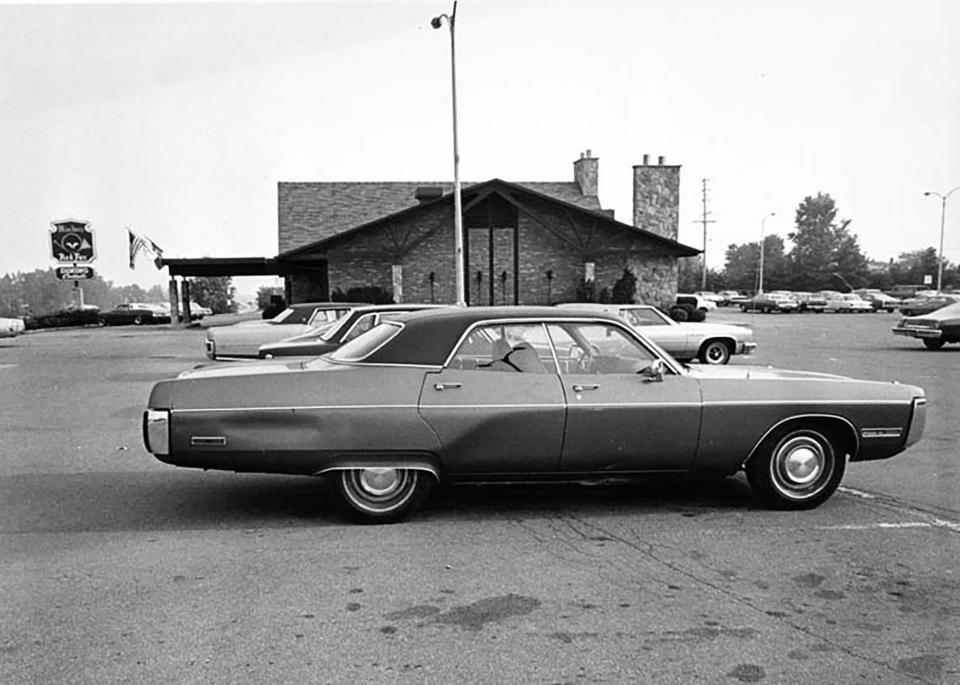
But no one was ever charged with his death.
Over the years, the FBI and other law enforcement conducted dozens of searches for Hoffa’s remains. Whenever word leaked that one was taking place, the search sites would become spectacles, with gawkers peering over the police tape, helicopters circling above and TV satellite trucks parked nearby.
One main suspect was Charles “Chuckie” O’Brien, a man said to be like a son to Hoffa. Witnesses described seeing Hoffa get into a car outside the restaurant. Investigators theorized O’Brien was driving.
He denied any involvement and died in 2020, taking to his grave whatever secrets he may have known.
— John Wisely
Martin Luther King Jr. first told of his dream in Detroit
The Rev. Martin Luther King Jr. spoke often in Detroit and, in 1963, led a massive march for civil rights down Woodward Avenue. That June 23, more than 125,000 people marched with King in what was the nation's largest civil rights march up to that time.
Later that summer, he delivered his most famous speech during the massive civil rights rally from the steps of the Lincoln Memorial. In Detroit, he previewed the "Dream" speech at the conclusion of the Woodward march.
Excerpts:
"So this afternoon, I have a dream.
"It is a dream deeply rooted in the American dream.
"I have a dream that one day right down in Georgia, in Mississippi, in Alabama, the sons of former slaves and the sons of former slave owners will be able to live together as brothers. ...
"I have a dream this afternoon that my four little children will not come up in the same young days that I came up within, but they will be judged on the basis of the content of their character and not the color of their skin. ...
"I have a dream this evening that one day we will recognize the words of Jefferson that all men are created equal. That they are endowed by their creator with certain inalienable rights, that among these are life, liberty and the pursuit for happiness. ...
"I have a dream this afternoon that the brotherhood of man will become a reality in this day ... with this faith we will be able to achieve this new day, when all of God’s children, Black men and white men, Jews and Gentiles, Protestants and Catholics will be able to join hands and sing with the Negro in the spiritual of old, 'Free at last! Free at last! Thank God almighty, we are free at last.' "
— Detroit Almanac
Misplaced anger leaves a man dead
On June 19, 1982, 27-year-old Vincent Chin was enjoying a night out at what was then the Fancy Pants strip club on Woodward Avenue in Highland Park. He and friends were celebrating ahead of his upcoming wedding. But what would happen next would spark national outrage and a movement for pan-Asian rights that continues today.
On that night, also at Fancy Pants were then-43-year-old Chrysler foreman Ronald Ebens and his 22-year-old stepson Michael Nitz, who had recently been laid off by Chrysler. At this time, the Motor City was struggling as Americans' tastes in cars had shifted to smaller, fuel-efficient Japanese cars. With American automakers losing sales to the Japanese, workers were losing jobs.
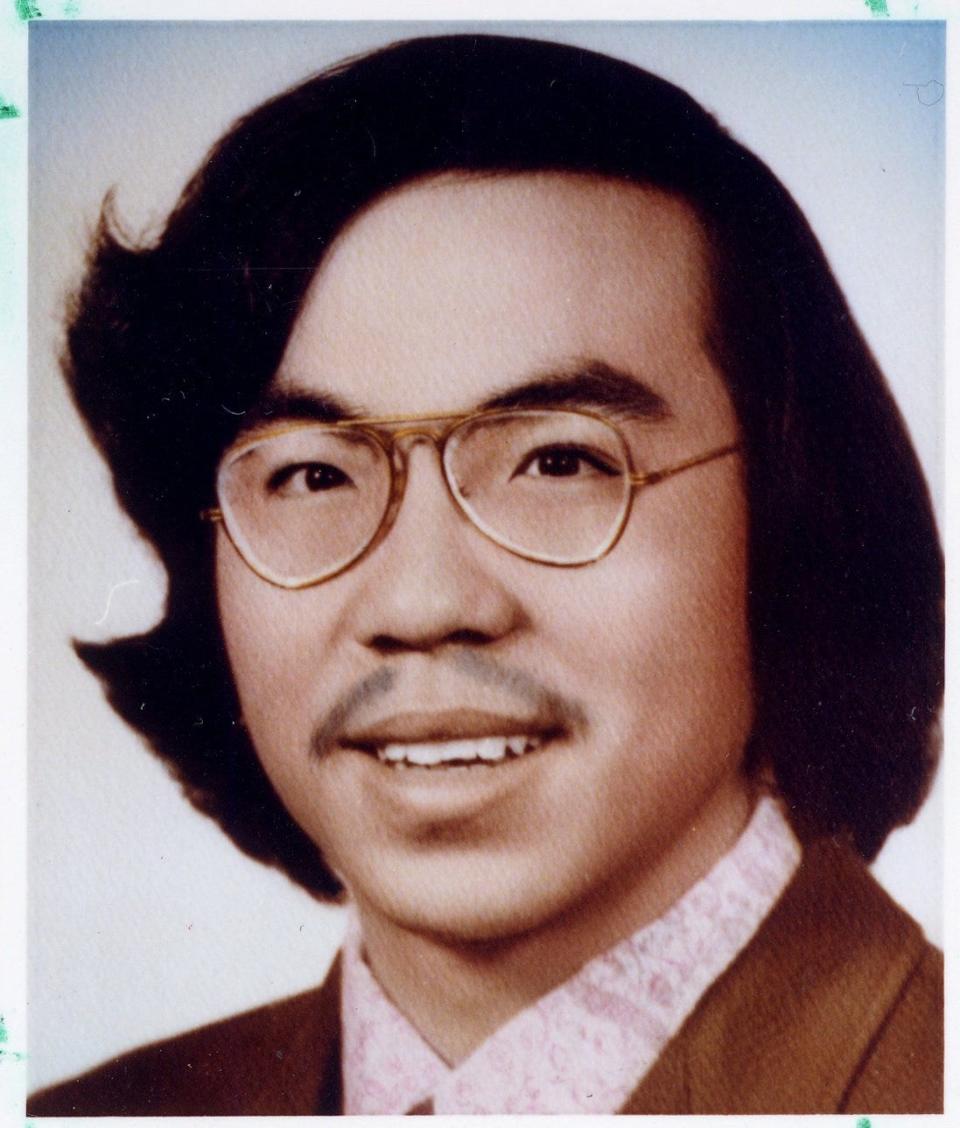
According to www.history.com, an argument started between the groups of men over a stripper. A dancer at the club said Ebens then shouted at Chin, “It’s because of you motherf***ers that we’re out of work.” Ebens and Nitz targeted Chin because they thought he was Japanese. He was actually Chinese-American and did not even work in the auto industry.
The dispute moved outside where Ebens grabbed a baseball bat from his car and began chasing Chin, who ran away. Ebens and Nitz drove around for about 20 minutes looking for Chin and when they found him, Nitz held Chin while Ebens hit him again, and again, and again with the baseball bat. Chin was declared brain dead at Henry Ford Hospital and died on June 23rd, 1982. His funeral was June 29, the day after what was supposed to be his wedding day.
Initially the brutal killing was a local story, but after the judge's light sentencing of Ebens and Nitz, it drew national attention and outrage. According to the Asian American Pacific Islander Resource Center at the University of New Mexico, Ebens and Nitz were originally charged with second-degree murder. The charge was brought down to manslaughter through a plea bargain and each man was sentenced by Judge Charles Kaufman to 3 years of probation and fined $3,000. They did not get any jail time. In defense of this ruling, Judge Kaufman said, “These weren't the kind of men you send to jail ... You don't make the punishment fit the crime; you make the punishment fit the criminal."
More: Landmark 'Who Killed Vincent Chin?' documentary airs on PBS as part of 40-year remembrances
The U.S. District Court sentenced Ebens to 25 years in prison for violating Chin’s civil rights in 1984. But in 1987 Ebens appealed and he got a retrial that cleared him of all charges. That same year, Ebens and Nitz settled a civil suit where Nitz was ordered to pay $50,000 to the Chin estate over 10 years, which he did. Ebens was ordered to pay $1.5 million. As of 2015, reports said it remains unpaid and has grown to about $8 million from accumulated interest over the decades.
— Jamie L. LaReau
An eight-year assisted suicide campaign
On a winter’s morning in early 1990, a gnomish man in his early 60s came to the Free Press building in downtown Detroit seeking to place a classified ad.
The proposed ad invited people suffering from a terminal illness or chronic pain to try out a device that promised to end a despondent patient’s life painlessly and efficiently via the injection of chemicals that would anesthetize the subject before stopping his or her heart.
The device’s inventor was a retired pathologist named Jack Kevorkian. The Free Press declined to publish Kevorkian’s proposed classified, but a reader ombudsman summoned to soothe the disappointed Kevorkian alerted Free Press columnist Neal Rubin, and Rubin’s column detailing Kevorkian’s then-nascent campaign to promote physician-assisted suicide appeared in the Free Press on March 18.
Less than three months later, Janet Adkins, a 54-year-old Oregon woman diagnosed with Alzheimer’s, become the first person to end her life with the device Kevorkian called the Thanatron. It was the beginning of an eight-year crusade in which Kevorkian would claim to have helped 130 patients end their lives.
Kevorkian’s efforts to gain acceptance for euthanasia triggered a massive pushback from a coalition of opponents that included law enforcement authorities, religious leaders and advocates for the disabled. An Oakland County judge dismissed criminal charges against Kevorkian in Adkins' death, ruling that nothing in state or federal law prohibited the assistance he provided. But Michigan quickly revoked his license to practice medicine, making it more difficult for him to obtain the controlled substances he used. Four more criminal prosecutions followed in the next seven years, each of which ended in an acquittal or mistrial.
In 1997, the Free Press published the results of an investigation into the 47 suicides Kevorian was then known to have assisted. Reporters found that, contrary to his assertions, most of the patients Kevorkian assisted had not been terminally ill, and fewer than half had complained of chronic pain. Autopsy results revealed that five assisted suicide patients had exhibited no evidence of any disease, and The Economist concluded that some whose suicides Kevorkian had assisted had likely “suffered from no more than hypochondria or depression.”
Kevorkian’s crusade — and his undefeated record in criminal prosecutions — ended abruptly in 1998, when he was charged murder in the death of Thomas Youk. Unlike Kevorkian’s previous assisted suicide patients, Youk, who suffered from Lou Gehrig’s disease, was physically unable to operate the Thanatron. So Kevorkian administered the lethal injection himself and provided a videotape documenting Youk’s death to CBS’s “60 Minutes.” A unanimous Oakland County jury convicted Kevorkian of second-degree murder, and he was sentenced to 10-25 years in prison, although then-Gov. Jennifer Granholm freed him after he had served only eight years.
Kevorkian died at 83 years of age in June 2011, four years after he was paroled. Today physician-assisted suicide is legal in 10 states (not including Michigan) and the District of Columbia.
— Brian Dickerson, special to the Free Press
A disgraced mayor goes to prison
The scandal began in January 2008, when the Detroit Free Press published excerpts of text messages exchanged between Mayor Kwame Kilpatrick and Christine Beatty, his chief of staff, on city-issued paging devices. The messages showed he and Beatty lied under oath during a police whistleblower trial. Their messages contradicted their testimony that they did not have a sexual relationship and showed they gave misleading statements about the firing of a deputy police chief, Gary Brown.
Perhaps even more explosive, however, was a secret deal the newspaper unearthed in a Freedom of Information Act lawsuit that Kilpatrick fought all the way to the state Supreme Court. The newspaper won access to a settlement agreement that showed Kilpatrick approved a deal in the whistleblower suit with Brown and two other ex-cops who sued him. In it, Kilpatrick agreed to pay the ex-cops $8.4 million, in part because they had obtained transcripts of his incriminating text messages. The ex-cops agreed to turn them over to the mayor and never speak of them again.
Despite the deal, the Free Press obtained copies of the messages and published excerpts with a story on the front page.
Kilpatrick fled the city to his Florida home and returned several days later for a televised apology from his church, with his wife at his side. "I would never quit on you. Ever," the mayor told Detroiters.
In March, Wayne County Prosecutor Kym Worthy announced a 12-count complaint charging perjury, conspiracy to obstruct justice, obstruction of justice and misconduct in office against Kilpatrick and Beatty, who announced her resignation in January.
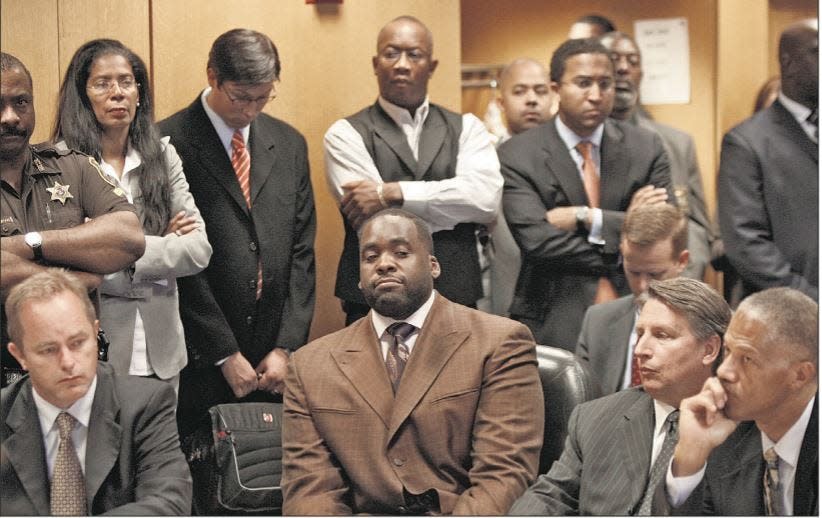
As part of a plea deal that followed months of tumult, Kilpatrick resigned in September 2008. The other terms included a sentence of four months in jail, a forfeiture of his law license and his pension from the state Legislature, a promise to pay up to $1 million in restitution and to serve five years of probation. Beatty cut her own deal and also went to jail.
Years later, Kilpatrick was indicted in a wide-ranging corruption scandal that included other allegations raised over the years in the Free Press. A judge locked him up for 28 years — one of the stiffest public corruption sentences in U.S. history.
In 2021, Kilpatrick was freed 20 years early after then-President Donald Trump granted him an early release, concluding he had paid his debt to society.
— Free Press archives
An Olympic kneecapping
“No ... Why me? Why now?”
Those were the anguished words of Olympic figure skater Nancy Kerrigan after a large man in a black leather coat ran toward her from behind and whacked her right knee with a metal baton. The assault, which took place in a Cobo Arena hallway on Jan. 6, 1994, was one of the most dramatic sports stories of the century, and it made headlines around the world for weeks.
Kerrigan was considered a gold-medal favorite in the upcoming Olympics.
Soon, Detroit police turned up information that associates of one of Kerrigan’s chief rivals, Tonya Harding, had plotted the crime. Before long, Harding’s ex-husband, Jeff Gillooly, was charged with planning and bankrolling the attack, and three of his friends confessed to being involved.
At the Olympics, the rehabilitated Kerrigan skated, as did the out-of-shape Harding. Kerrigan won a silver medal. Harding failed to place. After the Olympics, Harding pleaded guilty to hindering prosecution and was fined $100,000, sentenced to 500 hours of community service and banned for life by the U.S. Figure Skating Association. Kerrigan went on to become a millionaire skater.
— Detroit Almanac
Detroit's troubled summer of 1967
Police raided a private club above a print shop on the east side of 12th Street south of Clairmount about an hour before daylight on July 23, 1967. The club called itself the United Civic League for Community Action. But its action was dispensing booze after 2 a.m. In Detroit parlance, it was a blind pig.
A crowd formed as police brought the 82 arrested out of the second-story speakeasy. Someone hurled a brick that smashed the rear window of a police cruiser. Soon, rioters began overwhelming cops at the scene. Reinforcements were few because so many officers were on vacation. There were 193 police officers patrolling the entire city when the riot began.
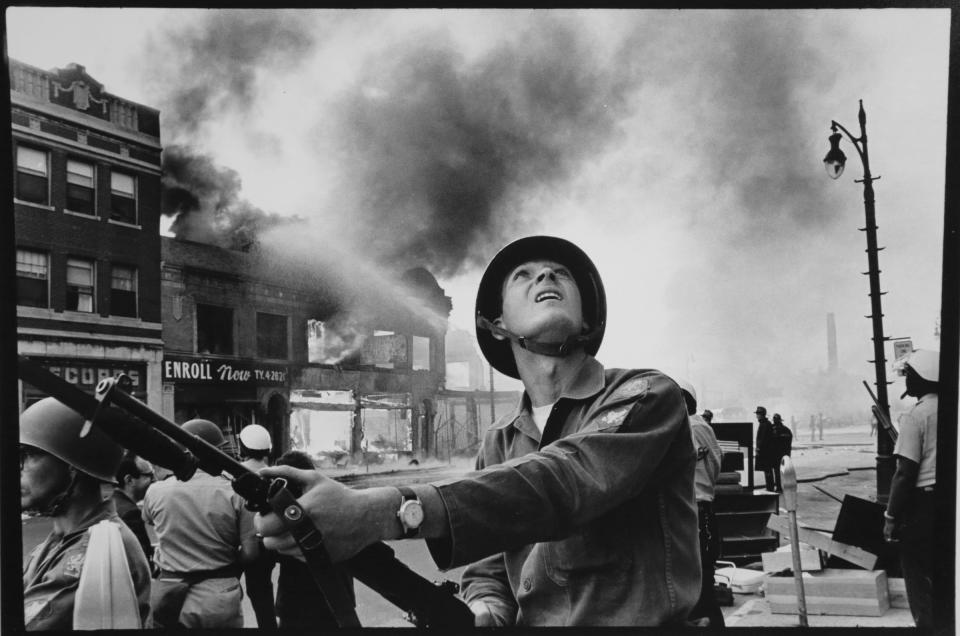
Rioting and looting spread along 12th Street, then to 14th, Linwood, Dexter and Grand River. By evening, rioting broke out on the east side near Van Dyke and Mack. Gov. George Romney activated the National Guard to help Detroit police and state police, but the guardsmen were poorly trained for quelling urban disturbances. They often overreacted, leading to needless deaths and injuries. Finally, President Lyndon B. Johnson ordered U.S. Army paratroopers from the 82nd and 101st Airborne Divisions to Detroit. By Friday, 4,400 Detroit police, 8,000 National Guardsmen, 4,700 federal troops and 360 state police were patrolling Detroit. Order was restored.
A deep polarization between races grew out of that riot, even though it was not a race riot. In fact, the first person killed was a white looter, Walter Grzanka, 45. He was shot by the owner of a market on Fourth Street.
The Kerner Commission, formed by Johnson after the Detroit disturbance and similar events in other U.S. cities, warned of impoverished central cities surrounded by affluent, white suburbs. The commission reported that "white racism is essentially responsible for the explosive mixture which has been accumulating in our cities since the end of World War II ... What white Americans have never fully understood — but what the Black can never forget, is that white society is deeply implicated in the ghetto. White institutions created it, white institutions maintain it and white society condones it."
— Detroit Almanac
Of course Harry Houdini died on Halloween
He escaped from chains, manacles and straitjackets. But he could not beat death. The great magician Harry Houdini died in Detroit on Halloween 1926.
Over the years, Detroiters had watched Houdini break free from handcuffs as he hung by his feet in Grand Circus Park and escape from a sealed trunk at the bottom of the Detroit River.
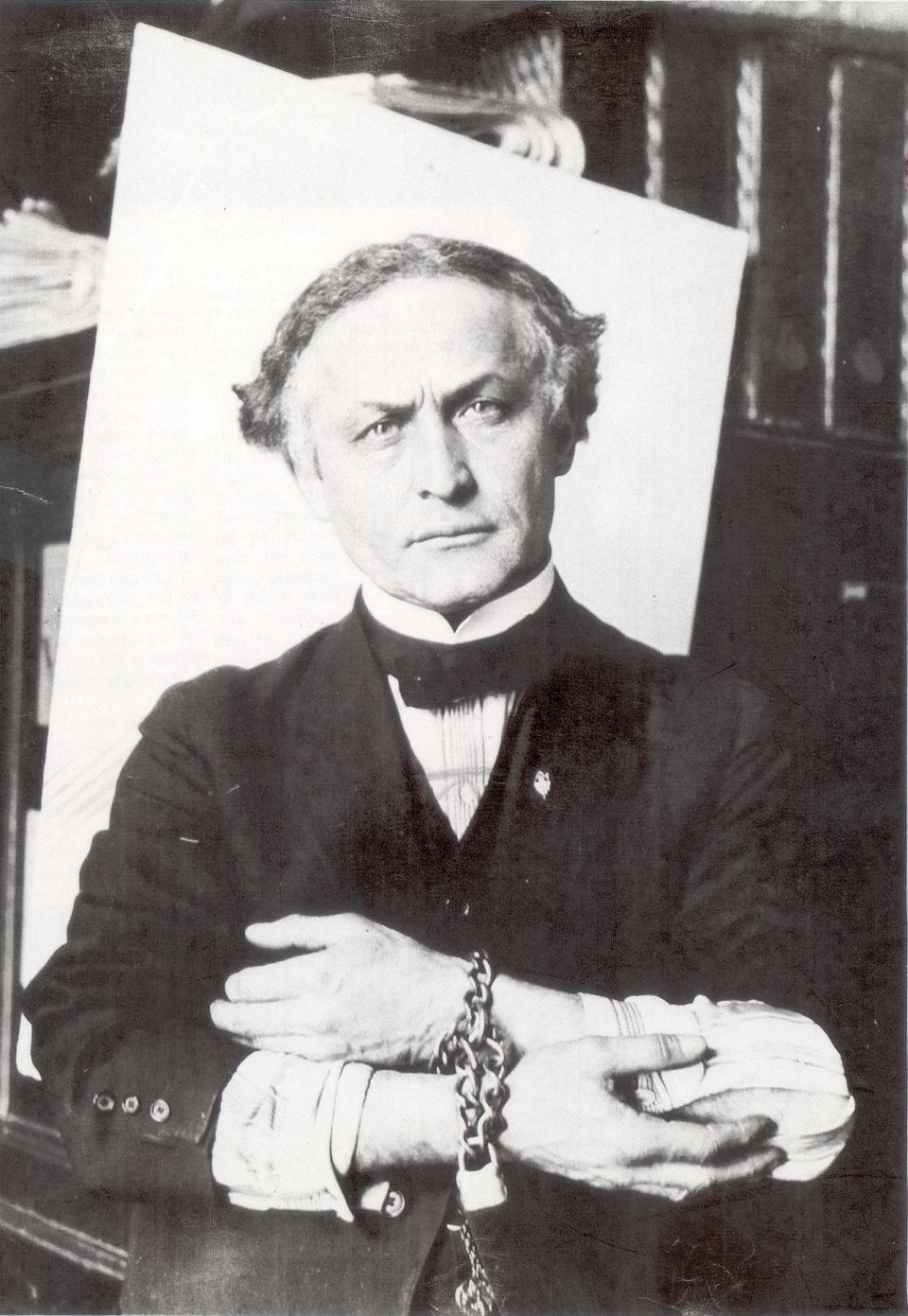
In what turned out to his last appearance, Houdini collapsed at Detroit’s Garrick Theater after his opening-night show. The crowd didn’t know it, but Houdini was suffering from being punched in the stomach by a fan three days earlier in Montreal in a test of the magician’s strength. After his collapse, Houdini was taken to Grace Hospital, where doctors removed his ruptured appendix. But poison had seeped into his bloodstream and he died three days later, at 1:26 p.m. Oct. 31. His brother, Theo, and wife, Bess, were at his bedside. Houdini’s last words: “Rosabelle, believe,” a reference to a song he and his wife enjoyed.
He had been staying at the Statler Hotel at Washington and Park Avenue, site of the new City Club Apartments, and he died at Grace Hospital, at the site of today's Detroit Medical Center.
— Detroit Almanac
A doubling of wages boosted the middle class
Henry Ford announced in January 1914 that he would double the rate of pay for workers at his Highland Park plant from $2.50 to $5 a day. Ford had introduced a full assembly line at the new factory to build Model Ts. It was stunning news, but came with caveats:
Workers had to apply for the raise.
Women were ineligible.
No one younger than 22 was eligible unless he was a breadwinner.
Workers had to submit to a probe of their private lives. Ford rewarded thrift, sobriety and cleanliness. Ford investigators reviewed personal financial information and visited the workers’ homes. They also interviewed neighbors and friends. In some cases, the investigators took photos of the workers’ dwellings, inside and out.
Requirements for the $5 wage included: Six months’ residency in Detroit and six months’ experience at Ford.
Ford introduced the $5-a-day pay in part because of high turnover. The speed of the line and working conditions are issues that never went away. In Highland Park in 1916, the Ford plant alone recorded 192 severed fingers, 68,000 lacerations, 5,400 burns and 2,600 puncture wounds, according to the Detroit Historical Museum.
— Detroit Almanac
This article originally appeared on Detroit Free Press: 9 Detroit events that went down in American history

